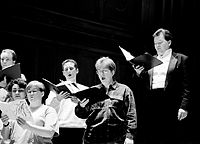

Why are there always so many old people at chorus concerts? In high school this was understandable; chorus was usually the largest group, and the one that required the least effort to participate in, and thus the adults attended to see their children or grandchildren. But through a number of chorus concerts here at Oberlin, this pattern has remained constant. Compared to the mostly student/faculty turnout at orchestra concerts, there are always a lot of senior citizens at vocal concerts.
An interesting test of this theory occurred last Sunday night, when the Dale Warland Singers came to Oberlin as the first installment in this season's Artist Recital Series. And, it held true: the majority of the audience consisted of neither students nor middle-aged upper-class types; instead, true to form, a sea of white hair stretched out across Finney Chapel.

Come to think of it, though, this wasn't that far removed. While the men wore tuxedos, the women wore black skirts with these odd sequined blouses that looked out of place on the rather formal-feeling stage of Finney. They came on like a high school chorus, in two rows walking awkwardly onto the risers, giving each other none-too-subtle tugs so everyone could fit on stage. It reminded me of nothing so much as sweaty "Spring Concerts" spent pressed up against a neighbor just a little damp and smelling more than a little of locker rooms.
Certainly the sound was very on-target and professional; their diminuendos were superb, their cutoffs crisp, and a difficult speaking part handled with taste. The range, especially in the bass section, was much wider than one normally hears (while remaining distinct) and they were confident when handling spoken harmonies. Two pieces demanded a "double choir," a task which both conductors and performers executed with precision.
But it's the little things that get noticed. The way the potentially powerful, ferocious piece "O vos omnes qui transitis per viam" by Ginastera (which includes the lines "my bowels are troubled" and "persevere in anger and crush them beneath the heavens, O Lord") came out limp and lacking. The way the spoken interludes were handled by various singers: stiffly, formally, with little life behind them. The way the final note in "I Heard a Voice from Heaven" was screeched out at glass-shattering volume by a pregnant transvestite soprano in the front row.
The concert was labeled "Cathedral Classics" and perhaps this is indicative of the basic problem with choral music; it's all sacred. There's a good reason for this, of course - most choirs are church choirs. But orchestras have had their share of controversies, back in the days when orchestral music mattered. When was choral music ever dangerous? When did anyone take any chances with it? It's no wonder that a certain spark seems to be lacking in most performances; there's nothing there to ignite.
One can certainly see some of this in the program choices: a minor Rachmaninoff, the composer du jour; a rather excellent piece by Herbert Howells, a modern composer; a choral version of Barber's Adagio for Strings; Lo, How a Rose e'er Blooming; and for the grand finale, the processional for Princess Di's funeral.
It's sad to see music wasted in this way, to hear the notes tumbling off the singers' lips with hardly a thought to their destination or source. There is such promise there; in the overtones you can almost hear the beauty that is nascent in the meaningless Latin words being said. But still there is that sadness, that regret at an opportunity wasted, and that sadness overwhelms whatever emotion that the Dale Warland Singers were trying to get across.
Temporary Contemporary: The Dale Warland Singers, who specialize in 20th century music, performed at Finney Chapel to a mostly non-college audience last weekend. (photo by John Matney)
Copyright © 1998, The Oberlin Review.
Volume 126, Number 14, February 13, 1998
Contact us with your comments and suggestions.